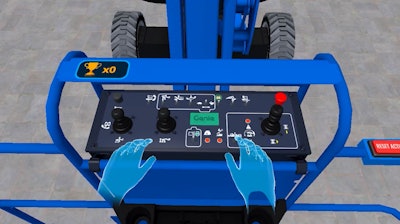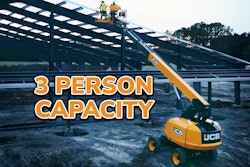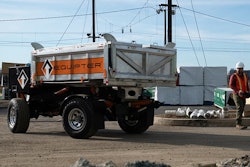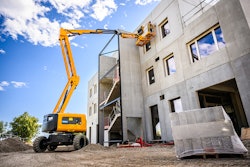
Genie’s new virtual reality training platform lets aerial equipment operators learn to avoid real-world hazards – from the safety of a virtual world.
Using a specially programmed Meta Quest 3 VR headset and two handheld controls, operators can participate in four different training scenarios. The simulations are designed to help familiarize users with the control and operation of a Genie Z45 FE articulated boom lift.
- Operations helps users gain familiarity with the lift’s controls.
- The Ghost Arena challenges operators to precisely position the machine to match a given outline.
- The Safety Gauntlet encourages users to navigate a virtual jobsite and avoid real-life hazards to collect trophies.
- And a Steel Erector simulator requires positioning the boom to weld steel beams onto a structure.
I had the opportunity to try out the technology at the recent ARA Show and can attest to how realistic it is. Much like the VR blooper videos all over the Internet, my first time using a VR headset was a little disorienting and otherworldly. It really feels like you’re on a moving machine, and at one point, I got a little wobbly.
To prevent real-world accidents or injuries, Genie says the simulation will shut off if you walk outside of a certain range. (Watch a clip of a Genie employee demonstrating the Ghost Arena simulation in the video below.)
“If I make a mistake, it’s in the virtual world, not the real world,” says Genie Training Director Scott Owyen. “But your mind doesn’t know the difference between virtual reality and reality.”
“If you tip the machine over, from a third-person perspective, you’ll see a crash dummy in the platform,” he adds. “Your mind will never forget that you experienced that, so when you’re in the real machine, you’ll think, ‘I don’t ever want to experience that again.’ It lets them learn about those hazardous situations before they ever get on.”
Development and Deployment
The training experience was developed in collaboration with software company that is experienced in creating virtual reality programs for a variety of applications and industries, including defense flight simulation.
Owyen says the investment was critical for advancing safety for those working at height. “We invested in this new training platform to positively enhance the training we provide and to prepare people for the actual scenarios they could encounter in the field. It’s not just a cool gimmick — it enhances learning and, therefore, safety.”
Initially, the VR training will be offered as an add-on to Genie’s train-the-trainer courses, which are more in-depth than operator qualification training. The courses, which prepare an individual to teach operator training, include a review of applicable standards and regulations, instruction on the training materials, time with actual equipment doing pre-operational inspections, functions tests and practice operating the equipment, as well as operator qualification training. The train-the-trainer class takes about 8-12 hours to complete, and the VR experience will add about an hour to class time.
Owyen says while the VR experience is intended as an add-on to the train-the-trainer class, there have been many requests to license it for use beyond Genie’s internal training centers. If requested, it can be made available for operator qualification training. However, the VR training will not be offered as a stand-alone class or a substitute for in-person training.
“While VR training feels very realistic, it simply can’t replace that real-world experience,” said Owyen. “But, allowing someone to practice what they’ve learned in a classroom, before going up in a lift, not only makes what they’ve learned more memorable, it enhances safety. That’s because, in a virtual world, you can experience a catastrophe without actually getting hurt. And, because the brain thinks it actually happened, it is an incredibly emotional and impressionable way to learn.”
To create the VR experience's visuals, the company used Genie CAD drawings, real-world specs, performance characteristics, videos of equipment operating, and sound recordings of an actual Z-45 FE boom.
The portable and size-adjustable headsets offer superior graphics and customized refresh rates that mirror how we see things in real life, reducing the chances that a participant will experience motion sickness.
“We chose to make the training self-contained to ensure robust performance. It doesn’t rely on internet access and we can take them to our customers, rather than requiring someone to come to us,” said Owyen.
While many train-the-trainer courses take place at Genie’s training centers in Rock Hill, South Carolina; Burleson, Texas; and Bothell, Washington, training also often occurs at a user’s location. “That might be out in the oil fields, underground in a salt mine, or any number of places with unreliable internet,” Owyen added.













